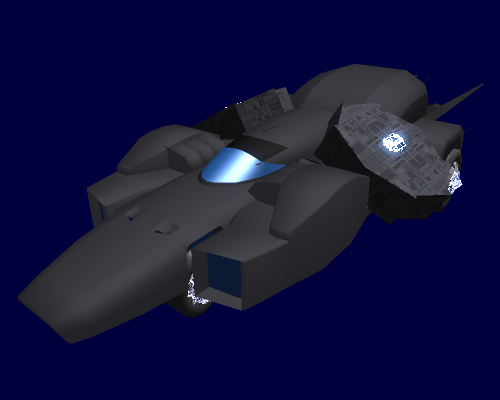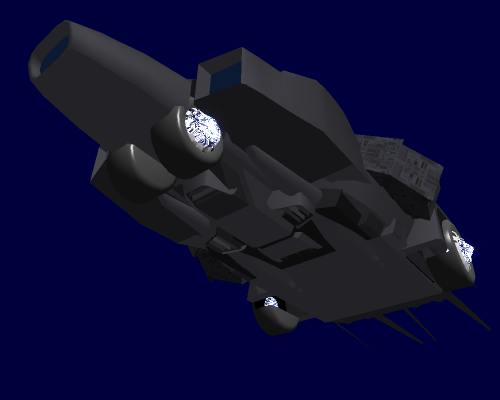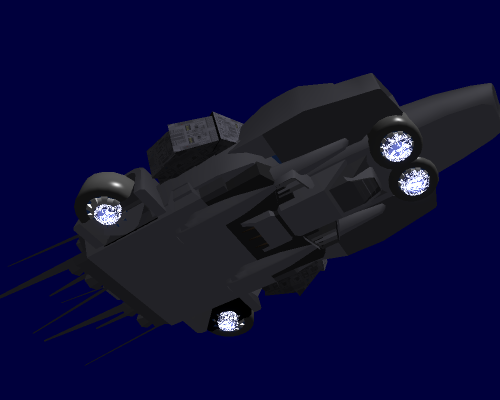Sidebar
Table of Contents
Merula-Class Personal Transport
Merula-Class personal transport craft are small one to five person air and space craft which are designed for the purpose of rapidly moving personnel and small cargo payloads between planets and star-systems. This design is of a civilian manufacture. This design is intended for a YE 33 release.
About the Ship
Merula-Class personal transport craft were designed for the purpose of replacing the dated Ferryman Shuttle, and to provide mass producible civilian space transportation.
Key Features
Designed with speed in mind, the Merula-Class personal transport has been built to incorporate massive engines, and a reasonably comfortable internal cabin for pilot comfort.
Mission Specialization
- Personal transportation
- Light cargo courier
Appearance
Designed with sleek curves, massive engines, and a centralized cockpit the Merula-Class resembles some sort of race car.
History and Background
With the continued expansion of the Lorath Matriarchy Matriarchy across planets and systems, a need for civilians to be able to freely travel between locations became prominent. Previously, the Ferryman Shuttle was the workhorse of civilian travel, though, with the design being considerably antiquated, the civilian branch of the Lorath Matriarchy's industrial base concluded that an up-to-date design with an entirely new chassis be introduced.
During early design phases of the Merula-Class, restructuring of the Matriarchy's design firms took place to optimize contribution to the United Manufacturing Cooperative. During restructuring of the design staff involved with the Merula, personnel from the Lorath Motor Vehicles division were transferred to the space craft design division. When confronted with the Merula-class design task, in the common manner of most Lorath, they threw themselves at the task using what they knew to the best of their abilities. What was produced from the process was a spacecraft which focused on speed, maneuverability, and style. Though, somewhere in the process, the designers did manage to sneak wheels with thrust systems into the design. Notably though, when design moved beyond the chassis and theory of function, much of the engineering involved reverted to drawing upon pre-existing Lorath designs including those of military origin.
Statistics and Performance
General
Class: LM-NCS-AS/G-02 Type: Personal Transport Shuttle & Ground Vehicle Designers: Lorath Matriarchy Matriarchy with contributions from United Manufacturing Cooperative Manufacturer: Lorath Matriarchy, United Manufacturing Cooperative. Production: Mass Production Fielded by: Domestic and Export Civilian Vehicle
Cost: 17,500 HS/KS For Standard Package.
Accessory Costs: 1,000 For Advanced Sensor Package, 500 For Pilot Specific Alterations To Cockpit, 100 For Cargo Container Life-support System Installation, 100 For Buyer Provided Equipment Installation.
Passengers
Crew: 1. Maximum Capacity: 4 Passengers.
Dimensions
Length: 5 meters (16.4 feet) (Not including thrust stabilizers Width: 2.3 meters (7.5 feet) Height: 1.5 meters (4.9 feet) Decks: Cockpit and Passenger Cabin
Propulsion and Range
Continuum Distortion Drive: 17,500c Hyperspace Fold Drive: .75 ly/m Sub-light Engines (Lorath Subspace Enhanced Fusion Plasma Engines): .375c with .75c boost. Atmospheric Speed: Mach 8 Electric Motor Ground Speed: 275 Mph Range: 100 LY @ FTL, Fusion System; 100 AU @ .375 Before Fuel Cell Depletion, 50 AU @ .75c Lifespan: 10 Years. Refit Cycle: 3 Months / 1,000 LY.
Damage Capacity
- Hull: ADR SP 12
- Shields: ADR SP 8 (Threshold 1)
Inside the Ship
Deck Layout
- Cockpit
- Cargo Hold
Compartment Layouts
Cockpit
Designed similar to the 'Cardinal' High Mobility Fighter, while extending the cockpit and widening it for three additional passenger seats in comparison to the Cardinal, placing two directly behind the pilot chair, with an additional two facing forward and set into the rear wall of the cockpit.
Rear Cargo Compartment
Placed in the rear-top of the vehicle, the rear cargo compartment can be accessed from above, and is designed to provide a 5x5x3 foot storage space for light cargo. This compartment can be outfitted to maintain atmospheric pressure.
Side Storage Compartments
Placed beside the cockpit hatch, the shuttle includes two small storage compartments on the exterior of the craft. These storage compartments are often used for emergency supplies, and storing small cargo items. These compartments are designed to be air-tight and can be outfitted to maintain a set temperature within the compartment.
Ship Systems
Armored Hull and Hull Integrated Systems
Merula-Class shuttles are comprised of a Durandium Alloy alloy exterior coating with a polymer composite underlay. A boron carbide insulation layer surrounds the cockpit compartment as well as cargo compartment.
Computers and Electronics
The Merula-Class utilizes Lorath vehicle and starship grade computing technology including the Neural Interface System.
System Interface
Neural Interface
A Neural Interface System is utilized to conduct high-speed commands and data access with the Merula's systems. The system aboard the Merula has been designed to be compatible with Jiyuuan, Lorath, Helashio, and ARIA bodies. Additional interface systems can be added per buyer request.
Volumetric Virtual Display
Through the use of precision holographic imaging and projected force-fields, a floating display like those found aboard typical starships can be produced. This display is capable of being interfaced with like a typical physically solid panel. With the Merula, this system is capable of also producing a simulated control interface which can be used to produce a number of various control surfaces as needed by the pilot.
Standard Interface Panels
The cockpit of the Merula includes standard flat panel interfaces which serve as displays and control access. These panels utilize high resolution displays, and an easily reconfigurable interface.
Emergency Interface System
The Merula includes a manual set of controls to allow for directly connected fly-by-wire to be utilized by the pilot in the event of computer system failure. These controls are fully capable of operating all shuttle functions through manual inputs.
Sensors
The Merula includes Common Sensor Package, however, it can be ordered with a full sensor compliment.
Communications
The Merula communications package includes the full range of Lorath Communications Systems technology.
Cockpit Systems
Integrated Cockpit Systems
Placed in front of the seat of the cockpit is the manual control interface, and OLED display. The manual control interface includes a single control stick which allows for the pilot to assume manual control of the shuttle, along with the stick, are a pair of pedals which handle other fine course adjustments. Also attached to the control stick, are the manual controls for the Merula’s accessory equipment. The manual controls of the Merula also include throttle, avionic control, electronic system overrides, sensors, communications, course input, cargo hold door opening and closing, power core ejection, thruster configuration, ejection, and environmental control. A second option for manual control includes a “two stick” configuration, which allows for the pilot to control yaw and pitch separately. The manual controls of the Merula can also be reconfigured to a pilot’s personal preferences.
The cockpit system also includes a pilot monitoring sensor package, and automated first aid system. This system is designed to monitor the pilot’s physical state, and deliver chemical medical aid as needed through the use of a self administering IV system.
The cockpit can be accessed through a double-locked hatch which requires both a neural verification, and access code input before access is granted and the magnetic and mechanical locks are disengaged, allowing for the hatch to be opened.
Cockpit Environmental System
Also included in the cockpit are various systems designed for pilot comfort, first and foremost being the environmental system. Atmosphere in the Merula’s cockpit is maintained through the use of oxygen and nitrogen emitting bacteria which are housed inside of a canister attached to the pilot’s seat. The oxygen and nitrogen provided by the environmental system is stored in holding tanks, and cycled into the cockpit as needed.
Housed in the seat of the cockpit is a waste extraction system, this system obviously must be configured depending on the pilot’s gender. The waste extraction system can also be attached to the pilot’s flight suit, if they prefer to wear an atmospheric suit, which would include a waste management system. The waste extraction system does not simply waste the organic matter, the organic matter is instead fed to the oxygen producing bacteria canister, and the electricity producing bacteria canisters of the vessel.
A system is also included in the cockpit to provide nutritional supplements to the pilot, the nutritional supplement solution is delivered to the pilot either through the use of an intervenes tube. The IV solution also includes an appetite suppressing drug which causes the pilot to have the illusion of being full.
Additional emergency systems include an organic Pico-Jelly material canister, a pico-jelly material dispensing device which can be used to dispense pico-jelly to be used for patching wounds, and as a Lorath standard, the cockpit pod also includes a cryogenic freeze system, in case of emergency which requires the pilot to enter stasis.
Neural Interface System
The primary method for control of the Merula in situations involving rapid responses and maneuvers is the neural interface system which has been put into use on modern day Lorath space vessels. The shuttle’s neural interface system has been modified to include additional features in contrast to early neural interface system units.
One of the features neural interface system includes a “psychosomatic sympathetic response system” (PSRS), the PSRS system allows for a pilot to “feel” the condition of their vessel. Some examples of what this system allows is for a pilot to have a simulated physical response when struck in combat, or to have the pilot feel when the vehicle is being pushed to it’s limits by feeling an artificial sensation of muscle strain.
G-Force Control System
The G-Force Control System is a series of gravity control devices which creates a stable gravitational field around the pilot of the Merula. This field is kept at 1G at all times, and prevents excessive G-forces from forcing a pilot to black out. Unfortunately, due to the small size of these units, their maximum compensation is limited to 15G, beyond this, G-Forces will be experienced by the pilot.
The G-Force Control System also serves as a scalar protection device for the pilot, additional G-Force Control System pods have been placed throughout the Merula to protect vital systems from stress damage, and Scalar attacks.
Ejection System
The entire cockpit of the Merula is designed to be ejected from the vessel; the cockpit module includes a small gravity manipulation device which would allow for the pod to be directed towards safety, but would not deliver enough thrust to get the pilot from one planet to another. The pilot pod is also able to endure atmospheric re-entry to allow for a safe planetary landing. Use of the pod for landing is handled through an automated system included inside of the pod and is independent of the Merula’s main computer. The gravity manipulation device also doubles as a scalar damage prevention measure.
Emergency Supplies
Located beneath the seat of the Merula is a supply kit container which includes;
- 2 Nutritional Supply Pack with two weeks nutritional supply.
- 2 Survival Knives, stamped metal construction, hollow handle, contains interactive volumetric star-chart projector.
Propulsion
Continuum Distortion Drive
Departing from traditional Lorath design, the Merula-Class has been built to mainly rely upon a Continuum Distortion Drive as a primary means of FTL travel. Drawing upon designs supplied by the United Manufacturing Cooperative, a CDD was installed upon the Merula-Class which is capable of creating a CDD-bubble large enough to enclose an Ayana-Class Escort. Instead of projecting a large bubble, the field has been configured to be projected tightly around the Merula, allowing for a greatly increased degree of performance by reducing the area effected in relation to power delivered. This drive system is built into a pair of large outboard field generator units.
Lorath Fusion Plasma Drive With Subspace Enhancement
Built into the rear-end of the Merula is a traditional Lorath fusion plasma propulsion system which has been enhanced with outboard extendable magnetic waveguides for thrust vectoring. Adding to the capabilities of the Merula at STL speeds is a low-power subspace field generator, which has been included for the purpose of reducing the gravitational constant of the craft, thus providing a power-to-mass alteration, allowing for the plasma thrusters of the Merula to achieve greater results in speed and maneuverability.
Limited Gravitic Drive
Embedded in the hubs of the Merula's ground mobility wheels are four gravitic field generators, used for in-atmosphere low-speed maneuvering, take-off, landing, hovering, and sub-supersonic velocities.
Ground Mobility System
Ground mobility for the Merula is accomplished through the use of an electric motor system. Wheels are comprised of vulcanized rubber with Stone Thread mesh. Wheels are designed with a built in air compression system which permits the wheels to be rapidly deflated and inflated, allowing for deflation during space travel to prevent pressure damage.
Hyperfold Drive
Included in the Merula's design is a hyperfold drive system, this drive system has been built into a pair of large field generator units which also double as the CDD field generator system. Due to being built upon the same high-power-to-size system, the hyperfold found aboard the Merula is capable of delivering impressive speeds.
Power Systems
QNC
Merula-class shuttles include a QNC system as their primary source of power for system operations, fusion initiation, and non-FTL drive system operation.
Fusion Generator & Particle Manipulator
Drawing upon power from the QNC included on the Merula, a fusion generator system uses laser based fusion systems and helium-3 fuel which has been a traditional staple for Lorath power production. Magnetic field systems are used to route the plasma produced from the fusion reactor to the STL drive system, while antimatter particles produced by the high-energy reaction are routed to a containment system, or routed to a vent system which safely vents antimatter at a controlled and safe rate.
A pair of matter gathering systems have been installed on forward facing scoops which are used to draw in usable fuel for the fusion generator system.
Note: Due to the high-performance nature of the fusion generator found aboard the Merula, a set of helium-3 tanks have been included, these tanks are used to provide matter to fuel the fusion reactor in the most efficient manner possible. Due to the need for helium-3 for optimal performance, Merula units require occasional refueling to ensure optimal performance. In emergency situations, alternate matter can be routed to the fusion system, yet, efficiency of the system would be impacted, while also posing a possible risk of system damage.
Mini-Antimatter Reactor
Using antimatter from the fusion generator system of the Merula, an antimatter reactor in miniature scale is fueled. This reactor draws upon the small amounts of antimatter produced by the fusion reactor to produce power which is used as a 'catalyst' for establishing hyperfold and CDD fields for FTL travel.
Magnetic Cycle Motor
A simple system, the magnetic cycle motor is a 'perpetual motion' system which is drawn upon to produce power for the electronics systems aboard the shuttle, as well as to provide power for the ground mobility systems of the shuttle.
Shield Systems
As something of an afterthought, a electromagnetic shield system has been installed upon the Merula for occupant safety, and to aid in reducing possible collisions with space debris.
Weapons Systems
- Rear Mounted 40mm Launching System: 1, DR Ammunition Dependent.
This launching system has been included to be used as a signal flare launching system, and has the capacity to receive ammunition from a feed tube which is located in the cockpit.
Page Tools
Terms of Service - Privacy Policy



